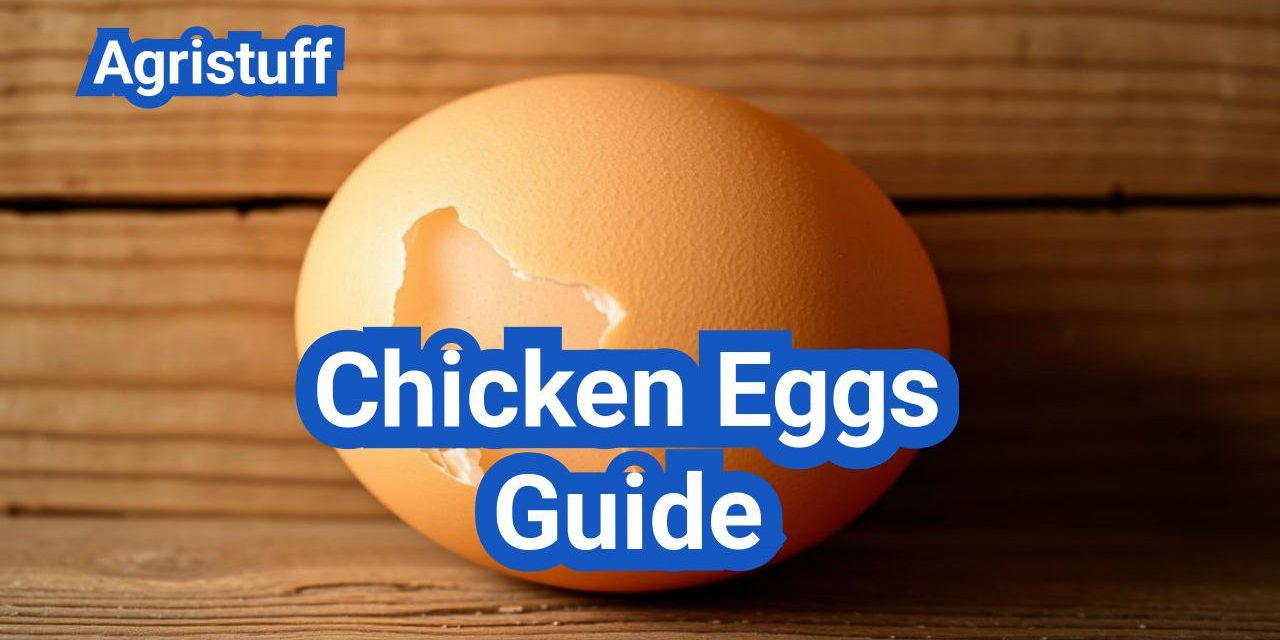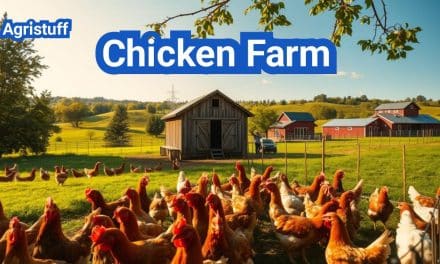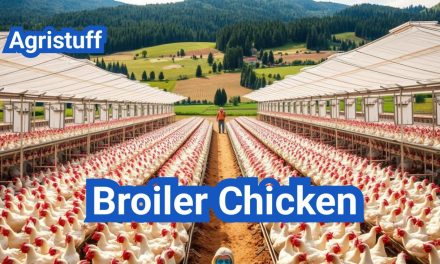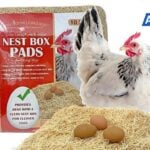Producing high-quality chicken eggs requires a combination of proper nutrition, breeding, and management practices. A balanced diet is crucial for optimal egg production, and layer feed formulation plays a significant role in this regard.
The quality of eggs is influenced by various factors, including the health and nutrition of the laying hens. Calcium for laying hens is particularly important, as it directly affects the strength and quality of the eggshell.
Key Takeaways
- Proper nutrition is essential for optimal egg production.
- A well-formulated layer feed is crucial for egg quality.
- Calcium supplementation is vital for strong eggshells.
- Management practices significantly impact egg production.
- Breeding plays a role in determining egg quality and production.
The Science Behind Chicken Eggs
Delving into the science behind chicken eggs reveals the intricacies of egg formation and development. The process of how chickens produce eggs is complex and influenced by various factors including genetics, nutrition, and environmental conditions.
Egg Formation and Development
Egg formation is a highly regulated process that occurs within the hen’s reproductive system. It involves the release of yolk from the ovary, which then travels through the oviduct where it is surrounded by egg white and shell membranes, and finally, the shell is formed.
The entire process takes around 24-26 hours, with the majority of time spent in the oviduct. Factors such as nutrition, health, and stress levels can affect the quality and production rate of eggs.
Fertilized vs. Unfertilized Eggs
A common question among consumers is whether the eggs they buy are fertilized or not. Most commercial eggs are unfertilized because they come from farms that keep hens without roosters. Fertilized eggs, on the other hand, are those that have been in contact with a rooster and have the potential to develop into an embryo if incubated properly.
- Fertilized eggs have a small white spot on the yolk known as the blastodisc.
- Unfertilized eggs lack this feature.
- The presence of a rooster is necessary for fertilization.
Comparing Chicken Eggs vs. Duck Eggs
While both chicken and duck eggs are consumed, there are significant differences between them. Duck eggs are generally larger, have a thicker shell, and a different taste profile compared to chicken eggs.
| Characteristics | Chicken Eggs | Duck Eggs |
|---|---|---|
| Size | Medium to Large | Large to Extra Large |
| Shell Thickness | Thinner | Thicker |
| Taste | Milder | Richer, often described as more ‘egg-like’ |
Understanding these differences can help consumers and producers alike make informed decisions about egg production and consumption.
Selecting the Best Chicken Breeds for Egg Production

To optimize egg production, it’s essential to understand the characteristics of different chicken breeds. The right breed can significantly impact the number and quality of eggs your hens produce.
Commercial Production Champions
For those looking to maximize egg production, certain commercial breeds stand out. These breeds are specifically bred for their high egg-laying capabilities and are often used in large-scale egg production operations.
- Isa Brown: Known for their reliability and high production rate, Isa Browns are a popular choice among commercial egg producers.
- Cream Legbar: This breed is not only a prolific layer but also produces eggs with a unique blue or green tint, adding value to the eggs.
- Black Copper Maran: While not as high in production volume as some other breeds, Black Copper Marans are prized for their dark, chocolate-brown eggs.
These commercial breeds offer a range of benefits, including high egg production rates and consistent quality. When selecting a breed for commercial egg production, it’s crucial to consider factors such as feed conversion efficiency, disease resistance, and egg size.
Heritage and Specialty Breeds
For backyard chicken keepers or those interested in unique egg production, heritage and specialty breeds offer a diverse range of characteristics. These breeds can add variety to your egg basket and often come with the bonus of unique egg colors or patterns.
- Silkie: Silkies are known for their fluffy feathers and friendly nature. While they are not the most prolific layers, their eggs have a special charm.
- Easter Eggers: Easter Eggers are a cross between an Ameraucana or Araucana and another breed, known for producing eggs in a variety of colors, including blue, green, and pink.
Heritage and specialty breeds can add a fun and unique element to your egg production. They may not produce as many eggs as commercial breeds, but they offer diversity and can be a great choice for small-scale or backyard operations.
Understanding Chicken Eggs Colors and Varieties
Exploring the different colors and varieties of chicken eggs reveals the fascinating diversity of poultry. Chicken eggs are not just a staple food; they come in a range of colors that can be attributed to the breed of the chicken.
White and Brown Egg Layers
The most common egg colors are white and brown. White egg layers include breeds like the Leghorn, known for their high egg production. Brown egg layers are often associated with breeds such as the Marans and the Barred Plymouth Rock. The eggshell color is determined by genetics, with some breeds laying eggs with a deeper brown tint.
- Leghorn: Known for laying white eggs.
- Marans: Famous for their dark brown eggs.
- Barred Plymouth Rock: A friendly breed that lays brown eggs.
Blue and Green Egg Layers (Easter Eggers)
Easter Eggers are known for laying blue and green eggs. These chickens are often a cross between a breed that lays blue eggs, like the Araucana, and another breed. The result is a variety of egg colors that can range from light blue to green.
- Araucana: Originates from Chile and lays blue eggs.
- Easter Egger: A crossbreed that can lay blue, green, or sometimes pink eggs.
Chocolate Brown Egg Layers (Marans)
The Marans breed is renowned for its chocolate brown eggs. This French breed is prized for its dark, rich egg color. Marans eggs are considered a delicacy by many due to their unique color.
Specialty Eggs (Silkie Chicken Eggs)
Silkie chickens are known for their fluffy feathers and friendly nature. While they lay white or cream-colored eggs, their unique characteristics make their eggs special. Silkies are not as prolific layers as some other breeds, but their eggs are cherished for their quality.
In conclusion, the variety of chicken eggs is a reflection of the diverse breeds of chickens. From white and brown to blue and green, each egg color has its unique charm and characteristics.
Creating the Optimal Diet for Laying Hens

A well-balanced diet is crucial for laying hens to produce high-quality eggs. The nutritional requirements of laying hens are complex and involve a delicate balance of various nutrients.
Layer Feed Formulation Essentials
Laying hens require a diet rich in proteins, vitamins, and minerals. Layer feed formulation is critical and typically includes ingredients such as corn, soybean meal, and calcium supplements. A good layer feed should have a balanced mix of energy and nutrients to support egg production.
“The formulation of layer feed is a science that requires careful consideration of the nutritional needs of laying hens,” says poultry nutrition expert Dr. Jane Smith.
“A well-formulated layer feed can significantly improve egg production and quality.”
Calcium Supplementation for Strong Shells
Calcium is a critical component of eggshell formation. Calcium supplementation is essential to ensure that laying hens have enough calcium to produce strong eggshells. Crushed oyster shells or limestone are common sources of calcium used in layer feeds.
Producing Nutrient-Rich and Omega-3 Enriched Eggs
To produce nutrient-rich and omega-3 enriched eggs, laying hens can be fed a diet supplemented with omega-3 fatty acids. This can be achieved by adding flaxseed or fish oil to their feed. Omega-3 enriched eggs are considered a healthier option for consumers.
- Flaxseed: Rich in alpha-linolenic acid (ALA), a type of omega-3 fatty acid.
- Fish oil: Direct source of EPA and DHA, beneficial for human health.
Seasonal Dietary Adjustments
Laying hens have different nutritional needs during various seasons. Seasonal dietary adjustments can help maintain optimal egg production. For example, during hot weather, hens may require more electrolytes to stay hydrated, while in cold weather, they may need more energy to maintain body heat.
| Season | Dietary Adjustment |
|---|---|
| Summer | Increase electrolytes |
| Winter | Increase energy |
Designing the Perfect Coop for Maximum Egg Production
Maximizing egg production starts with designing a coop that provides a comfortable, safe, and healthy environment for your hens. A well-designed coop is crucial for the overall well-being of your flock and directly impacts their productivity.
Nesting Box Setup and Management
Nesting boxes are a critical component of your coop, providing a safe and comfortable place for hens to lay their eggs. It’s recommended to have one nesting box per 3-4 hens. The boxes should be well-ventilated, kept clean, and lined with soft bedding material like straw or pine shavings.
Key considerations for nesting box setup include:
- Placement in a quiet, dark area of the coop
- Adequate size (typically 12 inches x 12 inches x 12 inches)
- Easy access for egg collection
- Proper ventilation to prevent ammonia buildup
Proper Ventilation and Temperature Control
Adequate ventilation is essential for removing moisture and ammonia from the coop, which can negatively impact hen health and egg production. Proper temperature control is also vital, as extreme temperatures can stress hens and reduce laying.
Ventilation tips:
- Ensure adequate airflow through windows, vents, or fans
- Monitor ammonia levels regularly
- Maintain a dry environment to prevent health issues
| Temperature Range | Ideal Conditions | Impact on Hens |
|---|---|---|
| 40°F – 70°F (4°C – 21°C) | Optimal for egg production | Hens are comfortable, and egg production is maximized |
| Below 40°F (4°C) | Supplemental heat may be needed | Potential decrease in egg production |
| Above 80°F (27°C) | Cooling measures are necessary | Risk of heat stress |
Coop Lighting Schedule for Year-Round Production
Lighting plays a significant role in egg production, as hens need a certain amount of daylight to maintain laying. A consistent lighting schedule can help ensure year-round production.
Lighting schedule recommendations:
- Provide 14-16 hours of light per day
- Use supplemental lighting during winter months
- Gradually adjust lighting to simulate natural daylight patterns
Space Requirements for Healthy, Productive Hens
Adequate space is crucial for the health and productivity of your hens. Overcrowding can lead to stress, reduced egg production, and health issues.
Space guidelines:
- Provide at least 3-4 square feet per hen inside the coop
- Ensure adequate outdoor space for foraging and exercise
- Monitor flock behavior to adjust space as needed
Managing Environmental Challenges for Consistent Laying

Environmental challenges such as heat stress and seasonal molting can significantly impact egg laying, necessitating effective management. Laying hens are sensitive to their environment, and factors like temperature, light, and nutrition play crucial roles in their productivity.
Preventing Heat Stress in Summer
Heat stress is a significant challenge during summer months. To prevent it, ensure proper ventilation in the coop and provide adequate shading. Cooling systems or fans can also be used to lower the temperature.
Cooling Measures:
- Increase ventilation
- Provide cool water
- Use shading or cooling systems
A well-ventilated coop is crucial for reducing heat stress. Consider the following table for managing heat stress:
| Method | Description | Benefits |
|---|---|---|
| Ventilation | Improving airflow | Reduces temperature, removes moisture |
| Shading | Blocking direct sunlight | Lowers coop temperature |
| Cooling Systems | Using fans or misting systems | Effectively lowers temperature |
Winter Egg Production Strategies
During winter, egg production can decrease due to shorter daylight hours and colder temperatures. To maintain production, consider supplementing with artificial lighting to provide a total of 14 hours of light per day.
Nutritional Adjustments:
- Increase calorie intake
- Ensure adequate calcium
- Provide warm water
Managing Seasonal Molting
Seasonal molting is a natural process, but it can be managed to minimize its impact on egg production. Ensure hens are well-nourished during this period, and consider reducing stress factors.
Nutritional Support During Molting:
- High-protein diets
- Adequate vitamins and minerals
- Stress reduction techniques
By implementing these strategies, farmers can better manage environmental challenges and maintain consistent egg production.
Egg Collection and Handling Protocols

Proper egg collection and handling are crucial for maintaining the quality and safety of eggs. Effective protocols ensure that eggs remain clean, intact, and fresh from the farm to the consumer.
Collection Frequency and Best Practices
Frequent egg collection is essential to prevent breakage and keep eggs clean. It’s recommended to collect eggs at least twice a day, with more frequent collections during peak laying periods.
- Collect eggs gently to avoid cracking.
- Use clean, dry containers or egg cartons for storage.
- Minimize handling to reduce the risk of breakage.
Proper Egg Washing Guidelines
Egg washing is a critical step in maintaining egg quality. However, it must be done correctly to avoid damaging the eggshell or introducing bacteria.
- Wash eggs in warm water (around 105°F) to help loosen dirt.
- Use a mild detergent specifically designed for egg washing.
- Dry eggs thoroughly after washing to prevent moisture from entering the egg.
Optimal Egg Storage Temperature and Methods
Proper storage is vital for maintaining egg freshness. The ideal storage temperature is between 45°F and 55°F, with a relative humidity of 70-80%.
Key storage tips:
- Store eggs in a cool, dry place.
- Keep eggs away from strong-smelling foods, as they can absorb odors.
- Use egg cartons or containers that allow for airflow.
By following these egg collection and handling protocols, producers can ensure that their eggs remain fresh and of high quality, meeting consumer expectations and maintaining a competitive edge in the market.
Assessing and Improving Chicken Eggs Quality

The quality of chicken eggs is a multifaceted trait that encompasses various characteristics, including size, shell integrity, and internal quality. Understanding these factors is crucial for producers aiming to enhance their egg production and for consumers seeking high-quality eggs.
Understanding Egg Sizes and Weights
Egg size is a critical determinant of egg quality, with larger eggs often commanding higher prices in the market. Egg sizes are categorized based on their weight, with the USDA defining six categories: Jumbo, Extra Large, Large, Medium, Small, and Peewee.
| Egg Size | Weight per Dozen |
|---|---|
| Jumbo | 30 ounces |
| Extra Large | 27 ounces |
| Large | 24 ounces |
| Medium | 21 ounces |
| Small | 18 ounces |
| Peewee | 15 ounces |
Egg weight is influenced by factors such as breed, nutrition, and age of the hen. For instance, younger hens tend to lay smaller eggs, while older hens produce larger ones.
Egg Candling Techniques and Applications
Egg candling is a technique used to evaluate the internal quality of eggs by shining a light through them. This method helps identify cracks, blood spots, and other defects.
Candling Process: The egg is held in front of a light source, typically a candling lamp, to inspect its contents. The light reveals the egg’s internal structure, including the size of the air cell, the presence of blood spots, and the clarity of the egg white and yolk.
Commercial Egg Grading Standards
Commercial egg grading standards are established to ensure consistency and quality in the egg industry. In the United States, the USDA’s Agricultural Marketing Service (AMS) is responsible for grading eggs.
“The USDA egg grading program is a voluntary program that provides a standardized system for grading eggs based on their quality and appearance.” – USDA
Eggs are graded as AA, A, or B based on factors such as cleanliness, shape, and internal quality. Grade AA eggs are considered the highest quality, with clean, sound shells and high-quality interiors.
Troubleshooting Common Egg Quality Issues
Common egg quality issues include cracked eggs, dirty eggs, and eggs with blood spots or other internal defects. Troubleshooting these issues involves identifying the root cause, such as nutritional deficiencies, health problems in the flock, or inadequate handling practices.
- Ensure proper nutrition for the hens to prevent deficiencies that can affect egg quality.
- Maintain a clean and healthy environment for the hens to reduce the risk of disease.
- Implement proper egg handling practices to minimize cracking and other damage.
By understanding and addressing these factors, producers can improve the overall quality of their eggs, enhancing their marketability and consumer satisfaction.
Hatching Your Own Chicken Eggs

The art of hatching chicken eggs requires patience, the right equipment, and a bit of knowledge. Whether you’re a seasoned poultry keeper or just starting out, understanding the process of hatching eggs can be a rewarding experience.
Selecting and Storing Eggs for Hatching
To successfully hatch chicken eggs, it’s crucial to start with the right eggs. Select eggs that are clean, well-formed, and come from a healthy flock. Avoid eggs that are cracked, dirty, or irregularly shaped, as these have lower chances of hatching.
Proper storage of hatching eggs is also vital. Eggs should be stored in a cool, dry place, pointed end down, at a temperature between 50°F to 60°F (10°C to 15°C). It’s recommended to turn stored eggs daily to prevent the yolk from sticking to the shell.
Incubator Selection and Setup
An incubator is essential for hatching chicken eggs. When selecting an incubator, consider factors such as temperature control, humidity management, and egg turning capabilities. There are various types of incubators available, ranging from manual to fully automatic models.
Once you’ve chosen an incubator, follow the manufacturer’s instructions for setup. Ensure that the incubator is in a draft-free area and that it’s level. Before adding eggs, let the incubator run for 24 hours to stabilize the temperature and humidity.
The 21-Day Incubation Process
The incubation period for chicken eggs is approximately 21 days. During this time, it’s crucial to maintain the right conditions. The ideal temperature is around 99°F to 100°F (37.2°C to 37.8°C), with humidity levels between 50% to 60% for the first 18 days, increasing to 65% to 70% for the last 3 days.
| Day | Temperature (°F) | Humidity (%) | Turning |
|---|---|---|---|
| 1-18 | 99-100 | 50-60 | 3-5 times/day |
| 19-21 | 99-100 | 65-70 | No turning |
Hatching Time and Chick Care Basics
As the incubation period comes to an end, eggs will start to pip and then hatch. This process can take up to 24 hours. Once the chicks have hatched, they need to be moved to a brooder. The brooder should be equipped with a heat source, as chicks require a warm environment.
Provide chicks with starter feed and ensure they have access to fresh water. Monitor the temperature in the brooder, typically starting at around 90°F to 95°F (32°C to 35°C) and reducing it by 5°F (3°C) each week until it reaches the ambient temperature.
Health Management for Productive Laying Flocks

Effective health management is crucial for maintaining productive laying flocks. Healthy hens are more likely to produce high-quality eggs consistently. Health management encompasses various aspects, including parasite control, disease prevention, and addressing production issues.
Preventing and Controlling Poultry Parasites
Poultry parasites, such as mites, lice, and worms, can significantly impact the health and productivity of laying hens. Regular monitoring and appropriate treatments are essential to prevent parasite infestations.
- Regularly inspect hens for signs of parasites.
- Use dust baths or sprays to control external parasites.
- Administer deworming medications as necessary.
Table: Common Poultry Parasites and Control Measures
| Parasite | Signs of Infestation | Control Measures |
|---|---|---|
| Mites | Restlessness, feather loss | Dust baths, sprays |
| Lice | Excessive preening, skin irritation | Insecticidal powders |
| Worms | Weight loss, diarrhea | Deworming medications |
Disease Prevention in Egg Layers
Disease prevention is critical for maintaining the health of laying hens. Vaccination programs, biosecurity measures, and proper nutrition play key roles in preventing diseases.
Vaccination Programs: Consult with a veterinarian to develop a vaccination schedule tailored to your flock’s needs.
Biosecurity Measures: Limit visitor access, use foot baths, and ensure proper disposal of manure to reduce disease risk.
Recognizing and Addressing Egg Production Problems
Egg production problems can arise due to various factors, including nutritional deficiencies, stress, and health issues. Identifying the root cause is essential to implement corrective measures.
- Monitor egg production records to identify trends.
- Check for signs of stress or nutritional deficiencies.
- Consult a poultry expert if production issues persist.
By implementing effective health management strategies, poultry farmers can maintain productive laying flocks and ensure a consistent supply of high-quality eggs.
Ensuring Egg Safety and Preventing Contamination

Safe egg production involves a multifaceted approach to prevent contamination. Ensuring the safety of eggs is critical for both backyard producers and commercial farmers to protect consumers from potential health risks.
Backyard Egg Safety Best Practices
For backyard chicken keepers, maintaining egg safety starts with a clean coop environment. Regularly cleaning the nesting boxes and collecting eggs frequently are essential practices. It’s also important to check eggs for any visible cracks or dirt.
Key practices include:
- Keeping the coop clean and dry
- Collecting eggs daily
- Storing eggs in a cool, dry place
Salmonella Prevention Strategies
Preventing Salmonella contamination is a critical aspect of egg safety. This involves implementing biosecurity measures on the farm or in the backyard, such as controlling rodents and other pests that can carry Salmonella.
Effective strategies include:
- Implementing strict biosecurity protocols
- Using Salmonella-controlled feed
- Regularly testing for Salmonella
Safe Handling and Consumption Guidelines
Safe handling practices are crucial from the point of egg collection to consumption. This includes proper washing and storage techniques, as well as handling eggs safely in the kitchen.
Guidelines for consumers:
- Refrigerate eggs promptly
- Use clean utensils and surfaces when handling eggs
- Cook eggs thoroughly before consumption
By following these guidelines and best practices, both producers and consumers can contribute to ensuring egg safety and preventing contamination.
Scaling Up: From Backyard to Small-Scale Chicken Eggs Farming

Scaling up from a backyard flock to a small-scale chicken eggs farming operation involves significant changes in management and infrastructure. As producers expand their operations, they must consider several critical factors to ensure a successful transition.
Equipment and Infrastructure Needs
One of the primary considerations when scaling up is the equipment and infrastructure required for larger-scale egg production. This includes:
- Expanded coop space and nesting boxes to accommodate more hens
- Automated feeding and watering systems to improve efficiency
- Enhanced ventilation and climate control systems to maintain a healthy environment
- Egg collection and handling equipment to reduce labor costs
Investing in the right equipment and infrastructure is crucial for maintaining the health and productivity of the flock, as well as ensuring the quality of the eggs produced.
Record Keeping and Production Management
Effective record keeping and production management are vital components of a successful small-scale chicken eggs farming operation. This includes:
- Tracking egg production rates and identifying trends
- Monitoring feed consumption and adjusting diets as necessary
- Maintaining health records for the flock, including vaccinations and medical treatments
- Analyzing financial data to optimize profitability
By maintaining accurate and detailed records, producers can make informed decisions to improve the efficiency and profitability of their operation.
Marketing and Selling Farm-Fresh Eggs
Developing a marketing strategy is essential for selling farm-fresh eggs to consumers. This may involve:
- Creating a brand identity and packaging that appeals to customers
- Establishing relationships with local retailers, restaurants, and farmers’ markets
- Utilizing online platforms and social media to promote products
- Offering value-added products, such as organic or specialty eggs
Effective marketing and sales strategies are critical for the success of a small-scale chicken eggs farming operation.
As the demand for farm-fresh eggs continues to grow, producers who can effectively market and sell their products will be well-positioned to capitalize on this trend.
Sustainable Egg Production for the Future
Sustainable egg production is crucial for the future of the poultry industry. Factors such as selecting the right chicken breeds and creating optimal diets for laying hens play a significant role in achieving sustainable egg production.
By implementing best practices in egg collection, handling, and storage, farmers can ensure the quality and safety of their eggs. The future of egg production relies on balancing productivity with environmental stewardship and animal welfare.
As demand for eggs grows, adopting sustainable practices will be essential for the industry’s long-term viability. Focusing on sustainable egg production will help ensure a prosperous future for the poultry industry, supporting the future of egg production.
FAQ
What are the key factors that influence chicken egg quality and production?
The key factors that influence chicken egg quality and production include nutrition, breeding, and management practices, such as layer feed formulation, calcium supplementation, and coop design.
What is the difference between fertilized and unfertilized chicken eggs?
Fertilized eggs are those that have been fertilized by a rooster and have the potential to develop into a chick, while unfertilized eggs are those that have not been fertilized and will not develop into a chick.
What are the most suitable chicken breeds for egg production?
The most suitable chicken breeds for egg production include commercial breeds like Leghorns and Isa Browns, as well as heritage breeds like Marans and Silkies, which are known for their egg-laying abilities.
What are the different colors and varieties of chicken eggs?
Chicken eggs come in a range of colors and varieties, including white, brown, blue, green, and chocolate brown, depending on the breed of the hen, such as Easter Eggers, Marans, and Silkies.
How can I ensure my laying hens receive the optimal diet?
To ensure your laying hens receive the optimal diet, provide a well-formulated layer feed, supplement with calcium to support strong eggshell production, and consider seasonal dietary adjustments.
What are the key elements of coop design for maximum egg production?
The key elements of coop design for maximum egg production include a well-designed nesting box setup, proper ventilation, temperature control, and a suitable lighting schedule.
How can I manage environmental challenges to promote consistent egg laying?
To manage environmental challenges, implement strategies to prevent heat stress, maintain winter egg production, and manage seasonal molting to promote consistent laying.
What are the best practices for egg collection and handling?
Best practices for egg collection and handling include regular collection, proper egg washing, and optimal egg storage temperature and methods to maintain egg quality.
How can I assess and improve the quality of my chicken eggs?
To assess and improve egg quality, understand egg sizes and weights, use egg candling techniques, and follow commercial egg grading standards to identify and address common egg quality issues.
What are the key considerations for hatching chicken eggs?
Key considerations for hatching chicken eggs include selecting and storing eggs for hatching, choosing the right incubator, and understanding the 21-day incubation process and chick care basics.
How can I maintain the health of my laying hens?
To maintain the health of your laying hens, implement parasite control measures, practice disease prevention, and recognize and address egg production problems promptly.
What are the best practices for ensuring egg safety?
Best practices for ensuring egg safety include following backyard egg safety guidelines, implementing Salmonella prevention strategies, and adhering to safe handling and consumption guidelines.
What are the key elements of scaling up to small-scale chicken eggs farming?
The key elements of scaling up to small-scale chicken eggs farming include assessing equipment and infrastructure needs, maintaining accurate records, and developing a marketing and sales strategy for farm-fresh eggs.
What is the importance of sustainable egg production?
Sustainable egg production is crucial for ensuring a consistent and safe egg supply while promoting animal welfare, environmental stewardship, and social responsibility.
Conclusion of: Chicken Eggs Guide
Why Chicken Eggs Matter to Every Farm and Backyard Flock
Chicken Eggs remain one of the most practical, nutritious, and profitable outputs on U.S. homesteads and small farms. Whether you sell cartons at a farm stand or simply want reliable breakfasts at home, Chicken Eggs can deliver steady value—if you optimize quality, safety, and production. This guide walks you through how Chicken Eggs are graded, what affects their nutritional and aesthetic qualities, and how to dial in daily management so Chicken Eggs stay clean, safe, abundant, and marketable.
For more on small-scale egg economics, see University of Minnesota Extension’s poultry resources.
Quick Nutrition Snapshot for Chicken Eggs
Chicken Eggs pack high-quality complete protein with modest calories and a rich mix of vitamins (notably B-12, D, and choline). For everyday planning, Chicken Eggs are widely considered a concentrated, affordable protein you can scale on small acreage. Framed correctly in your flock nutrition plan, Chicken Eggs also respond to feed choices (like added omega-3 sources), housing, and stress control—so your nutrition strategy and coop management both show up in the quality of your Chicken Eggs.
Learn about egg nutrition from Harvard T.H. Chan School of Public Health.
Understanding Consumer Grades and Sizes of Chicken Eggs
To sell or simply benchmark quality, it helps to know how Chicken Eggs are classified. “AA,” “A,” and “B” describe interior and exterior quality (firm whites, yolk appearance, air cell depth, and clean, sound shells). Size—Jumbo, Extra Large, Large, Medium, Small, and Peewee—refers to minimum net weight per dozen, not shell dimensions. If you market your Chicken Eggs locally, learning how clean shells, tight whites, and proper handling preserve Grade A/AA appearance can lift your price and customer satisfaction.
Refer to the USDA Egg Grading Manual for official standards.
Eggshell Color, Yolk Color, and What They Really Mean
People often assume brown Chicken Eggs are more nutritious than white, or that deep orange yolks always mean “healthier.” In practice, shell color is determined by breed and doesn’t change the inside of Chicken Eggs. Yolk color mostly reflects carotenoids in the hen’s diet (for example, alfalfa, marigold, or pasture greens), not a guaranteed nutrition bump. Focus your management on feed quality and bird health; do that well and your Chicken Eggs will earn consistent praise regardless of shell color.
Explore yolk color science via Penn State Extension.
The big levers that control how many Chicken Eggs you get
- Light schedule: Chicken Eggs come more regularly when hens receive about 14–16 hours of light daily. In fall/winter, a simple timer can supplement daylight so your flock’s biological rhythm still favors laying.
- Nutrition: Layer rations for Chicken Eggs must balance energy, amino acids, minerals, and vitamins. Consistent feed supports consistent laying.
- Water: Birds drink roughly twice as much water (by weight) as feed. In heat, water intake can jump; clean, cool water is the cheapest way to stabilize Chicken Eggs output.
- Health and parasites: Lice and mites drain birds and visibly depress Chicken Eggs production. A quarterly check and quick treatment when needed keeps hens laying.
- Temperature stress: Heat reduces feed intake and, fast, that reduces Chicken Eggs and shell quality. Shade, airflow, and extra drinkers are essential once temps spike.
- Age and molt: Pullets ramp up, mature hens peak, and older hens gradually lay fewer Chicken Eggs with thinner whites and shells. During molt, most hens pause production—this is normal.
For lighting tips, see Iowa State University’s poultry guidelines.
Housing & space that protect quality in Chicken Eggs
Tight quarters trigger pecking, stress, and dirty eggs. As a rule of thumb for Chicken Eggs production, aim for 3–4 ft² of indoor coop space per hen and generous run space. Enough perches and good airflow cut down condensation and ammonia; those both protect the bloom on Chicken Eggs and keep shells clean.
Read best practices from Oregon State University Extension.
Nesting that keeps Chicken Eggs clean
Clean nests are the fastest path to clean Chicken Eggs. Offer one nest for about every 4–5 hens and keep boxes bedded, dry, and slightly dim. Mount nests away from roosts so birds won’t sleep in them. Collect Chicken Eggs at least once daily (twice is better) so eggs don’t get cracked, pecked, or soiled.
Nest box design tips from Purdue University.
Feed fundamentals that show up in Chicken Eggs
For layers, calcium is non-negotiable for strong shells on Chicken Eggs. Typical layer feeds sit around 2.5–3.5% calcium; many keepers also offer free-choice oyster shell so hens can self-regulate. Keep crude protein appropriate for your birds’ stage and production goals; too little protein or energy quickly shows up as fewer Chicken Eggs and paler yolks. For specialty markets, controlled amounts of flaxseed or other omega-3 sources can enrich the fatty acid profile of Chicken Eggs, but don’t overdo inclusion rates—follow proven formulas to avoid off-flavors or loose droppings.
Nutrient requirements from National Research Council.
Water: the overlooked driver of Chicken Eggs
Dehydrated hens don’t eat, and hens that don’t eat don’t lay Chicken Eggs. As a planning number, if a hen eats ~0.25 lb of feed, expect ~0.5 lb of water intake under normal conditions. In hot weather, hens may need double. Put waterers in shade, keep them scrubbed, and distribute extras so timid birds still drink. You’ll see steadier Chicken Eggs output just by elevating hydration and cleanliness.
Heat stress playbook for summer Chicken Eggs
When temps rise, provide shade (natural or shade cloth), crank ventilation, add more water stations, freeze water jugs in drinkers, and reduce afternoon flock stress. Some managers also use short-term vitamin/electrolyte support during heat waves. The payoff is fewer production slumps and fewer thin-shelled Chicken Eggs when the mercury climbs.
Heat management strategies from University of Georgia Extension.
Handling and cleaning routines that preserve Chicken Eggs
- Collect promptly. Freshly laid Chicken Eggs are warmer than the coop air, and sitting in nests invites cracks and soil.
- Dry clean first. Brush off small specks with a dedicated cloth or sanding sponge.
- If you wet-wash, do it right. Use water warmer than the eggs (≥90°F and at least 20°F warmer than the egg), then sanitize and dry. Cold water can pull microbes into shells; hot, correctly sanitized water helps push contaminants away.
- Separate defects. Don’t sell cracked or leaking Chicken Eggs; cook any slightly imperfect eggs at home (well done), and discard leakers.
- Date your cartons. Rotate stock so the oldest Chicken Eggs go first.
Storage & food safety that keep Chicken Eggs safe for families
- Refrigerate fast at ≤40°F (4°C).
- Use within 3–5 weeks for best quality (hard-cooked Chicken Eggs within 1 week).
- Keep in original cartons (reduces odor absorption and moisture loss) and store pointy end down to stabilize the air cell.
- Cook thoroughly. Dishes with Chicken Eggs should reach 160°F; whole eggs should have firm whites and yolks.
- Practice biosecurity. Keep rodents and wild birds out of the coop area to reduce contamination risks for Chicken Eggs.
FDA egg safety guidelines: www.fda.gov.
Lighting schedules to steady year-round Chicken Eggs
Laying is hormonally tied to day length. In short days, use a timer to bring total light to 14–16 hours/day. Gentle pre-dawn lighting works well (e.g., lights on before sunrise, off after sunrise), avoiding sudden bedtime blackouts. This simple step keeps Chicken Eggs coming consistently through winter without “forcing” birds harshly.
Troubleshooting common quality issues in Chicken Eggs
- Thin shells: Check calcium access first; verify your layer feed and top up free-choice oyster shell. Heat stress and old age can also thin shells on Chicken Eggs.
- Watery whites: Often age-related in hens or from long storage; fresher Chicken Eggs have higher, tighter albumen.
- Blood spots: Benign; they come from tiny vessel ruptures during ovulation and don’t mean the egg is fertilized. Remove the spot and cook as usual.
- Double yolks: Common in young pullets ramping up; fun to find and safe to eat, though you may avoid them in precise baking.
- Sudden drop in Chicken Eggs: Think through feed (freshness and intake), water, light hours, parasites, heat stress, or an impending molt.
A simple, season-by-season plan for better Chicken Eggs
- Spring: Transition pullets onto layer feed as first Chicken Eggs appear; expand nests; confirm rodents are under control.
- Summer: Heat-proof the coop; place extra shaded waterers; collect Chicken Eggs more often to beat heat.
- Fall: Add timed lighting as day length drops; check calcium supplies; do a mite/lice inspection before winter.
- Winter: Keep litter dry, ventilation moving, and water thawed; continue light schedule so Chicken Eggs don’t skid to a halt.
Marketing tips to add value to your Chicken Eggs
If you sell direct:
- Label size and grade appearance clearly so buyers know what to expect from your Chicken Eggs.
- Consistency wins—clean shells, uniform cartons, and a quick freshness note (packed-on date) build repeat customers.
- If you enrich omega-3 or manage pastured flocks, describe the husbandry rather than making unverified nutrition claims for Chicken Eggs.
Final thought
With a few focused habits—clean nests, correct light, balanced feed, steady water, and quick, cool storage—you’ll see cleaner shells, tighter whites, stronger yolks, and more dependable baskets of Chicken Eggs. Keep notes, adjust one lever at a time, and your hens will pay you back in premium Chicken Eggs all year.
For a seasonal checklist, visit Homesteading Family.
Research notes & sources
- Safe storage & cooking temps for eggs — Refrigerate at ≤40°F, use within 3 weeks for best quality; egg dishes to 160°F, cook eggs until whites and yolks are firm. U.S. Food and Drug Administration
- USDA grades & candling basics — AA/A/B interior quality; candling criteria and handling practices for shell integrity. Ask USDAAMS
- Size classes by weight (per dozen) — Jumbo 30 oz, Extra Large 27 oz, Large 24 oz, etc. Ask USDA
- Shell color vs nutrition — Brown vs white shells show no meaningful nutrient difference; it’s breed, not nutrition. Ask USDA
- Yolk color is diet-driven — Carotenoids in feed (e.g., alfalfa/marigold) deepen yolk color; color ≠ guaranteed superior nutrition. PMC+1
- Lighting for lay — Hens lay best around 14–16 hours of light per day. blog.redmondagriculture.comStrong Animals
- Calcium for shells — Typical layer rations run ~2.5–3.5% Ca; offer free-choice oyster shell for high producers. Poultry ExtensionAlabama Cooperative Extension System
- Water intake rule — Birds consume about 2:1 water:feed by weight; ~0.25 lb feed → ~0.5 lb water; needs rise in heat. Alabama Cooperative Extension SystemOSU Extension
- Heat stress hurts production and shell quality — Physiological stress lowers lay rate and egg quality; management (shade/airflow) helps. PMCUniversity of Minnesota Extension
- Parasites reduce egg output — Mites/lice depress condition and cut egg production without quick control. Poultry ExtensionUA Cooperative Extension
- Space & nest guidance — 3–4 ft²/hen indoors, and 1 nest per ~4–5 hens; clean, dry nesting material. Poultry ExtensionUniversity of Maryland ExtensionAsk IFAS – Powered by EDIS
- Egg collection & washing — Collect at least daily; if washing, keep water ≥90°F and ≥20°F warmer than the eggs; sanitize and dry promptly. AgriLife TodayAMSNebraska Extension Publications
- Pointy end down in storage — Stabilizes the air cell and helps maintain quality during refrigeration. Penn State Extension
- Omega-3 enrichment — Flaxseed in layer diets significantly increases omega-3 content of Chicken Eggs. Poultry Extension













